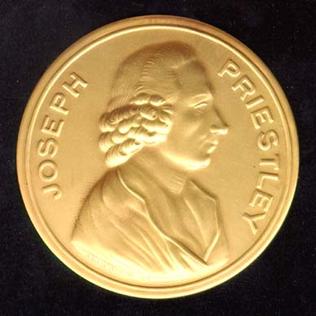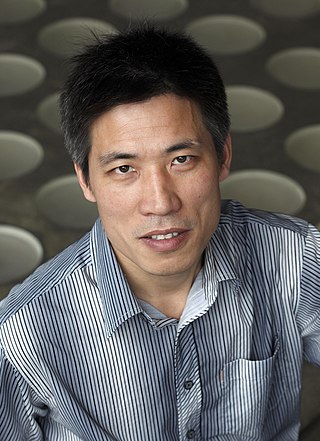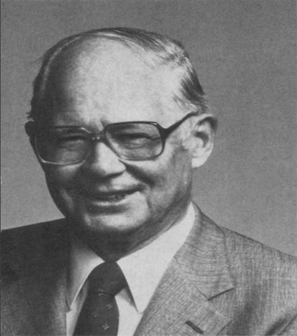Related Research Articles

Ira Remsen was an American chemist who introduced organic chemistry research and education in the United States along the lines of German universities where he received his early training. He was the first professor of chemistry and the second president of Johns Hopkins University. He founded the American Chemical Journal, which he edited from 1879 to 1914. The discovery of Saccharine was made in his laboratory by Constantine Fahlberg who worked in collaboration with Remsen but patented the synthesis on his own, earning the ire of Remsen.

The American Chemical Society (ACS) is a scientific society based in the United States that supports scientific inquiry in the field of chemistry. Founded in 1876 at New York University, the ACS currently has more than 155,000 members at all degree levels and in all fields of chemistry, chemical engineering, and related fields. It is one of the world's largest scientific societies by membership. The ACS is a 501(c)(3) non-profit organization and holds a congressional charter under Title 36 of the United States Code. Its headquarters are located in Washington, D.C., and it has a large concentration of staff in Columbus, Ohio.

The Priestley Medal is the highest honor conferred by the American Chemical Society (ACS) and is awarded for distinguished service in the field of chemistry. Established in 1922, the award is named after Joseph Priestley, one of the discoverers of oxygen, who immigrated to the United States of America in 1794. The ACS formed in 1876, spearheaded by a group of chemists who had met two years previously in Priestley's home.

Samuel Philip Sadtler, Ph.D., LL.D. was an American chemist, and the first president of the American Institute of Chemical Engineers in 1908.

Richard Neil Zare is the Marguerite Blake Wilbur Professor in Natural Science and a Professor of Chemistry at Stanford University. Throughout his career, Zare has made a considerable impact in physical chemistry and analytical chemistry, particularly through the development of laser-induced fluorescence (LIF) and the study of chemical reactions at the molecular and nanoscale level. LIF is an extremely sensitive technique with applications ranging from analytical chemistry and molecular biology to astrophysics. One of its applications was the sequencing of the human genome.

Anna Jane Harrison was an American organic chemist and a professor of chemistry at Mount Holyoke College for nearly forty years. She was the first female president of the American Chemical Society, and the recipient of twenty honorary degrees. She was nationally known for her teaching and was active nationally and internationally as a supporter of women in science.

Mary Lowe Good was an American inorganic chemist who worked academically, in industrial research and in government. Good contributed to the understanding of catalysts such as ruthenium which activate or speed up chemical reactions.
John William Mullin FRSc FIChemE FREng was a Ramsay Memorial Professor of Chemical Engineering and world expert in crystallisation.
The UCL Faculty of Engineering Sciences is one of the 11 constituent faculties of University College London (UCL). The Faculty, the UCL Faculty of Mathematical and Physical Sciences and the UCL Faculty of the Built Envirornment together form the UCL School of the Built Environment, Engineering and Mathematical and Physical Sciences.
Harry Linn Fisher was the 69th national president of the American Chemical Society, and an authority on the chemistry of vulcanization. Fisher was the author of four popular books on the chemistry and technology of rubber, and the holder of 50 patents.
The Chemical Industry Medal is an annual American award given to an industrial chemist by the Society of Chemical Industry America. The medal has been awarded since 1933, when it replaced the Grasselli Medal. It was initially given to "a person making a valuable application of chemical research to industry. Primary consideration shall be given to applications in the public interest." As of 1945, the criterion became "a person who ... has rendered conspicuous service to applied chemistry." More recently it has been awarded "for contributions toward the growth of the chemical industry."

John H. Beynon FRS was a Welsh chemist and physicist known for his work in mass spectrometry.
Sarah Elizabeth Reisman is the Bren Professor of Chemistry and the Chair of Division of Chemistry and Chemical Engineering at California Institute of Technology. She received the (2013) Arthur C. Cope Scholar Award and the (2014) Tetrahedron Young Investigator Award for Organic Synthesis. Her research focuses on the total synthesis of complex natural products and data-driven developments of asymmetric catalysis.
Herman Pines was a Russian Empire–born American chemist best known for his work with Vladimir Ipatieff on the catalytic conversion of high-octane aviation fuel. Because of his scientific contributions, new processes were developed for the isomerization of paraffins, the alkylation of aromatic compounds, and base-catalyzed organic reactions.
Nora Henriette de Leeuw is the inaugural executive dean of the Faculty of Engineering and Physical Sciences at University of Leeds. Her research field is computational chemistry and investigates biomaterials, sustainable energy, and carbon capture and storage.
The Percy L. Julian Award was first given in 1975 by the National Organization for the Professional Advancement of Black Chemists and Chemical Engineers (NOBCChE). The award is given every one to two years. It honors black scientists who have made significant contributions to the areas of pure or applied research in science or engineering.
Betty Julia Sullivan was an American biochemist between the 1920s and 1940s at Russell Miller Milling Company. In 1947, Sullivan began her executive career as research director and vice-president for Russell Miller until the company became part of Peavey Company in 1958. After the merger, Sullivan remained in her executive roles before leaving in 1967 to co-start an agribusiness consulting company. While working at Experience Inc., Sullivan became director of the company in 1975 and retired in 1992. During her career, Sullivan was the first woman to receive the Osbourne Medal from the American Association of Cereal Chemists, in 1948. In 1954, Sullivan was awarded the Garvan–Olin Medal from the American Chemical Society.

Junwang Tang, MAE, FRSC and FIMMM, is the Founding Director of Industrial Catalysis Center, and Carbon Neutrality Chair Professor of Materials Chemistry and Catalysis at the Department of Chemical Engineering, Tsinghua University and Visiting Professor at University College London (UCL). He also served as the Director of the University Material Hub at UCL (2016–2019).

Warren Dexter Niederhauser was an American chemist who was the President of the American Chemical Society (ACS). He worked at of Rohm and Haas chemical company from 1943 to 1985.
The Ramsay Memorial Chair of Chemical Engineering is a named professorship in the Department of Chemical Engineering at UCL, established along with the department and the Ramsay Memorial Laboratory in 1923. They are named after Nobel Price recipient William Ramsay. The chair was the first created for Chemical Engineering in the United Kingdom. The current professor is Marc-Olivier Coppens.
References
- ↑ "The Guardian from London, Greater London, England pg.11". 25 June 1923. Retrieved 31 March 2021.
- ↑ "University and Educational Intelligence". Nature. 112 (2809): 346–347. 1 September 1923. Bibcode:1923Natur.112R.346.. doi: 10.1038/112346b0 . S2CID 4074831.
- 1 2 Michael Sanderson (11 October 2018). The Universities and British Industry: 1850–1970. Routledge. ISBN 978-1138323568.
- ↑ "University and Educational Notes". Science. 58 (1490): 48. 20 July 1923. Bibcode:1923Sci....58...48.. doi:10.1126/science.58.1490.48. PMID 17834626 . Retrieved 31 March 2021.
- ↑ "Scientific Notes and News". Science. 66 (1719). Science New Series Published By: American Association for the Advancement of Science: 556–560. 9 December 1927. Bibcode:1927Sci....66..556.. doi:10.1126/science.66.1719.556. JSTOR 1650987.
- ↑ "Personal and Other Business". Journal of the Society of Chemical Industry. 46 (48): 1129-1132 Correspondence. 2 December 1927. doi:10.1002/jctb.5000464804.
- ↑ D. C. Freshwater (1997), People, pipes and processes: a short history of chemical engineering and the Institution of Chemical Engineers
- 1 2 Nicholas A. Peppas (1989), One hundred years of chemical engineering, Springer, ISBN 9780792301455
- ↑ "History - UCL Chemical Engineering has a long and distinguished history as a world-leading research department – the first of its kind in the UK. Find out more about some key figures and dates in our history". University College London. 19 July 2018. Retrieved 31 March 2021.
- ↑ f. g, D. (17 February 1934). "Prof. W. E. Gibbs". Nature. 133 (3355): 240. Bibcode:1934Natur.133..240F. doi: 10.1038/133240a0 . S2CID 4118542.
- ↑ "Governing Board of the American Institute of Physics, Minutes of Meeting". 15 March 1941. Retrieved 31 March 2021.
- ↑ Negley Harte, John North, Georgina Brewis (21 May 2018). The World of UCL. UCL Press. ISBN 978-1787352940 . Retrieved 31 March 2021.
{{cite book}}: CS1 maint: multiple names: authors list (link) - ↑ "Industrial Research, United States National Resources Board 1939 pg. 284–285". 1939. Retrieved 31 March 2021.
- ↑ "MADE RESEARCH DIRECTOR; Dr. E.C. Williams Also Named to General Mills's Board". New York Times. 2 October 1941. Retrieved 31 March 2021.
- ↑ "Utilization of Farm Crops. Industrial Alcohol and Synthetic Rubber. : hearings before the United States Senate Committee on Agriculture and Forestry, Subcommittee on S. Res. 224, Seventy-Seventh Congress, second session, on Mar. 20, 24, 25, 27, Apr. 2, 21–24, 30, May 5, 7, 8, 12, 15, 19, 21,1942". 1942. Retrieved 31 March 2021.
- ↑ Administration of the Trading with the Enemy Act. United States Senate, Subcommittee on the Trading with The Enemy Act on the Committee on the Judiciary. 20 February 1953. p. 322. Retrieved 31 March 2021.
- ↑ "Chemical Engineers Meet in Boston". Chemical & Engineering News. 20 (10). Chem. Eng. News: 660–666. 25 May 1942. doi:10.1021/cen-v020n010.p660 . Retrieved 31 March 2021.
- ↑ "Modern Petroleum Research". Chem. Eng. News: 630–633. 10 December 1938. doi:10.1021/cen-v016n023.p630 (inactive 18 September 2024).
{{cite journal}}: CS1 maint: DOI inactive as of September 2024 (link) - ↑ "Bibliography of Aeronautics". Institution of Aeronautical Science. January 1941.